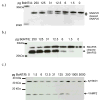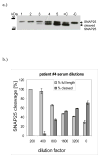A neuronal cell-based botulinum neurotoxin assay for highly sensitive and specific detection of neutralizing serum antibodies
- PMID: 17889852
- PMCID: PMC2748649
- DOI: 10.1016/j.febslet.2007.08.078
A neuronal cell-based botulinum neurotoxin assay for highly sensitive and specific detection of neutralizing serum antibodies
Abstract
Clostridium botulinum neurotoxin (BoNT) serotypes A and B are widely used as pharmaceuticals to treat various neurological disorders and in cosmetic applications. The major adverse effect of these treatments has been resistance to treatment after multiple injections. Currently, patients receiving BoNT therapies and patients enrolled in clinical trials for new applications and/or new formulations of BoNTs are not routinely monitored for the formation of neutralizing antibodies, since no assay other than the mouse protection procedure is commercially available that reliably tests for the presence of such antibodies. This report presents a highly sensitive and specific neuronal cell-based assay that provides sensitive and specific detection of neutralizing antibodies to BoNT/A.
Figures




Similar articles
-
SiMa Cells for a Serotype Specific and Sensitive Cell-Based Neutralization Test for Botulinum Toxin A and E.Toxins (Basel). 2017 Jul 20;9(7):230. doi: 10.3390/toxins9070230. Toxins (Basel). 2017. PMID: 28726719 Free PMC article.
-
A protein chip membrane-capture assay for botulinum neurotoxin activity.Toxicol Appl Pharmacol. 2008 Dec 15;233(3):439-46. doi: 10.1016/j.taap.2008.09.005. Epub 2008 Sep 19. Toxicol Appl Pharmacol. 2008. PMID: 18845174
-
Progress in cell based assays for botulinum neurotoxin detection.Curr Top Microbiol Immunol. 2013;364:257-85. doi: 10.1007/978-3-642-33570-9_12. Curr Top Microbiol Immunol. 2013. PMID: 23239357 Free PMC article. Review.
-
Detection of type A, B, E, and F Clostridium botulinum neurotoxins in foods by using an amplified enzyme-linked immunosorbent assay with digoxigenin-labeled antibodies.Appl Environ Microbiol. 2006 Feb;72(2):1231-8. doi: 10.1128/AEM.72.2.1231-1238.2006. Appl Environ Microbiol. 2006. PMID: 16461671 Free PMC article.
-
Critical Analysis of Neuronal Cell and the Mouse Bioassay for Detection of Botulinum Neurotoxins.Toxins (Basel). 2019 Dec 7;11(12):713. doi: 10.3390/toxins11120713. Toxins (Basel). 2019. PMID: 31817843 Free PMC article. Review.
Cited by
-
Persistence of botulinum neurotoxin a subtypes 1-5 in primary rat spinal cord cells.PLoS One. 2014 Feb 27;9(2):e90252. doi: 10.1371/journal.pone.0090252. eCollection 2014. PLoS One. 2014. PMID: 24587301 Free PMC article.
-
Emerging Opportunities in Human Pluripotent Stem-Cells Based Assays to Explore the Diversity of Botulinum Neurotoxins as Future Therapeutics.Int J Mol Sci. 2021 Jul 14;22(14):7524. doi: 10.3390/ijms22147524. Int J Mol Sci. 2021. PMID: 34299143 Free PMC article. Review.
-
Botulinum Neurotoxins Can Enter Cultured Neurons Independent of Synaptic Vesicle Recycling.PLoS One. 2015 Jul 24;10(7):e0133737. doi: 10.1371/journal.pone.0133737. eCollection 2015. PLoS One. 2015. PMID: 26207366 Free PMC article.
-
Holotoxin Activity of Botulinum Neurotoxin Subtype A4 Originating from a Nontoxigenic Clostridium botulinum Expression System.Appl Environ Microbiol. 2014 Dec;80(23):7415-22. doi: 10.1128/AEM.01795-14. Epub 2014 Sep 19. Appl Environ Microbiol. 2014. PMID: 25239905 Free PMC article.
-
Human Induced Pluripotent Stem Cell Derived Neuronal Cells Cultured on Chemically-Defined Hydrogels for Sensitive In Vitro Detection of Botulinum Neurotoxin.Sci Rep. 2015 Sep 28;5:14566. doi: 10.1038/srep14566. Sci Rep. 2015. PMID: 26411797 Free PMC article.
References
-
- Johnson EA. Clostridium botulinum and Clostridium tetani. In: Borriello SP, Murray PR, Funke G, editors. Topley and Wilson’s Microbiology and Microbial Infections. 8. Hodder Arnold; London: 2005. pp. 1035–1088.
-
- Gimenez DF, Gimenez JA. The typing of botulinal neurotoxins. Int J Food Microbiol. 1995;27:1–9. - PubMed
-
- Montecucco C, Molgo J. Botulinal neurotoxins: revival of an old killer. Curr Opin Pharmacol. 2005;5:274–279. - PubMed
-
- Fischer A, Montal M. Crucial role of the disulfide bridge between botulinum neurotoxin light and heavy chains in protease translocation across membranes. J Biol Chem. 2007 Jul;:31. Epub ahead of print. - PubMed
Publication types
MeSH terms
Substances
Grants and funding
LinkOut - more resources
Full Text Sources
Other Literature Sources

